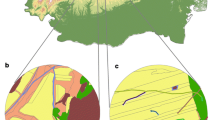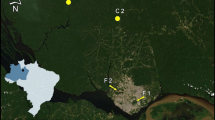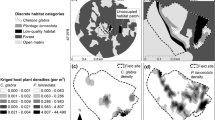Abstract
Context
Intensive use of agricultural land often modifies the landscape by dividing continuous natural habitat into smaller and more isolated patches. While the effects of habitat fragmentation on species abundance and diversity have been widely studied, little is known about how fragmentation impacts the function of organisms that do persist in the modified environment. Understanding these effects is complicated by the fact that fragmentation can affect organisms directly but also indirectly, by altering the patch microclimatic conditions.
Objectives
We tested the hypothesis that fragmentation-induced microclimate change might be an important mechanism driving changes in animal locomotion in an agricultural landscape.
Methods
We used satellite image analysis, behavioral assays, and patch analyses, to disentangling the direct and indirect effects of fragmentation on the locomotor behavior of a darkling beetle, Zophosis punctata (Tenebrionidae), in the Southern Judea Lowlands in Israel.
Results
We found that fragmentation in an agricultural ecosystem may lead to changes in the thermal conditions of natural habitat patches. Importantly, such fragmentation-related increases in patch temperature played an important role in explaining variation in beetle locomotion across an agricultural landscape. Specifically, beetles from highly fragmented landscapes, which included warmer habitat patches, showed high locomotor intermittence -frequent pausing events during locomotion.
Conclusions
This study shows that the potential consequences of habitat fragmentation on organism function are likely to be underestimated when fragmentation-related microclimate change is ignored. Intermittent locomotion, as opposed to steady locomotion, may provide physiological and fitness benefits in fragmented landscapes, like mitigating performance limitations imposed by extreme thermal conditions.




Similar content being viewed by others
Data availability
Data are shared privately for-peer review in a figshare repository https://figshare.com/s/ab2abfef546ca0f10848. If paper is accepted for publication, data will be permanently archived in this same repository.
References
Aiken LS, West, SG (1991) Multiple regression: testing and interpreting interactions. Sage Publications, Incorporated, Newbury Park
Alexander RMN (2005) Models and the scaling of energy costs for locomotion. J Exp Biol 208:1645–1652
Allsopp PG (1980) The biology of false wireworms and their adults (soil-inhabiting Tenebrionidae) (Coleoptera): a review. Bull Entomol Res 70:343–379
Angilletta MJ, Steury TD, Sears MW (2004) Temperature, growth rate, and body size in ectotherms: fitting pieces of a life-history puzzle. Integr Comp Biol 44:498–509
Arroyo-Rodríguez V, Saldaña-Vázquez RA, Fahrig L, Santos BA (2017) Does forest fragmentation cause an increase in forest temperature? Ecol Res 32:81–88
Baguette M, Legrand D, Fréville H et al (2012) Evolutionary ecology of dispersal in fragmented landscape. In: Clobert J, Baguette M, Benton TGBJ (eds) Dispersal ecology and evolution. Oxford University Press, Oxford, pp 381–391
Bender DJ, Tischendorf L, Fahrig L (2003) Using patch isolation metrics to predict animal movement in binary landscapes. Landsc Ecol 181(18):17–39
Bergerot B, Merckx T, Van Dyck H, Baguette M (2012) Habitat fragmentation impacts mobility in a common and widespread woodland butterfly: do sexes respond differently? BMC Ecol 12:5
Bivand RS, Pebesma E, Gómez-Rubio V (2013) Applied spatial data analysis with R, 2nd edn. Springer, New York
Boyle MJW, Bishop TR, Luke SH et al (2021) Localised climate change defines ant communities in human-modified tropical landscapes. Funct Ecol 35:1094–1108
Castro AV, Porrini DP, Cicchino AC, Scharf I (2014) Annual activity density of groundbeetles (Coleoptera: Carabidae) of a Celtis ehrenbergiana (Rosales: Celtidaceae) Forest of Buenos Aires Province, Argentina. J Insect Sci. https://doi.org/10.1093/jisesa/ieu114
Chen J, Saunders SC, Crow TR et al (1999) Microclimate in forest ecosystem and landscape ecology: variations in local climate can be used to monitor and compare the effects of different management regimes. Bioscience 49:288–297
Chown SL, Pistorius P, Scholtz CH (2011) Morphological correlates of flightlessness in southern African Scarabaeinae (Coleoptera:Scarabaeidae): testing a condition of the water-conservation hypothesis. Can J Zool 76:1123–1133
Davis ALV, Chown SL, Scholtz CH (1999) Discontinuous gas-exchange cycles in Scarabaeus dung beetles (Coleoptera: Scarabaeidae): mass-scaling and temperature dependence. Physiol Biochem Zool 72:555–565
De Heij SE, Benaragama D, Willenborg CJ (2022) Carabid activity-density and community composition, and their impact on seed predation in pulse crops. Agric Ecosyst Environ 326:107807
Ewers RM, Banks-Leite C (2013) Fragmentation impairs the microclimate buffering effect of tropical forests. PLoS ONE 8:e58093
Ferrante L, Baccaro FB, Ferreira EB et al (2017) The matrix effect: how agricultural matrices shape forest fragment structure and amphibian composition. J Biogeogr 44:1911–1922
Ferraz G, Nichols JD, Hines JE et al (2007) A large-scale deforestation experiment: effects of patch area and isolation on Amazon birds. Science (80–) 315:238–241
Full RJ, Zuccarello DA, Tullis A (1990) Effect of variation in form on the cost of terrestrial locomotion. J Exp Biol 150:233–246
Gavish Y, Ziv Y, Rosenzweig ML (2012) Decoupling fragmentation from habitat loss for spiders in patchy agricultural landscapes. Conserv Biol 26:150–159
Giladi I, Ziv Y, May F, Jeltsch F (2011) Scale-dependent determinants of plant species richness in a semi-arid fragmented agro-ecosystem. J Veg Sci 22:983–996
Goosem M (2001) Effects of tropical rainforest roads on small mammals: inhibition of crossing movements. Wildl Res 28:351–364
Haddad NM, Brudvig LA, Clobert J et al (2015) Habitat fragmentation and its lasting impact on Earth’s ecosystems. Sci Adv 1:e1500052
Hargis CD, Bissonette JA, David JL (1998) The behavior of landscape metrics commonly used in the study of habitat fragmentation. Landsc Ecol 13:167–186
Harper KA, Macdonald SE, Burton PJ et al (2005) Edge influence on forest structure and composition in fragmented landscapes. Conserv Biol 19:768–782
Hill JK, Thomas CD, Blakeley DS (1999) Evolution of flight morphology in a butterfly that has recently expanded its geographic range. Oecologia. https://doi.org/10.1007/s004420050918
Holben BN (1986) Characteristics of maximum-value composite images from temporal AVHRR data. Int J Remote Sens 7:1417–1434
Jensen JR (2009) Remote sensing of the environment: an Earth resource perspective, 2nd edn. Pearson Education India, New Delhi
Klepsatel P, Gáliková M (2022) Developmental temperature affects thermal dependence of locomotor activity in Drosophila. J Therm Biol 103:103153
Kramer DL, McLaughlin RL (2001) The behavioral ecology of intermittent locomotion. Am Zool 41:137–153
Lachenicht MW, Clusella-Trullas S, Boardman L et al (2010) Effects of acclimation temperature on thermal tolerance, locomotion performance and respiratory metabolism in Acheta domesticus L. (Orthoptera: Gryllidae). J Insect Physiol 56:822–830
Latimer CE, Zuckerberg B (2017) Forest fragmentation alters winter microclimates and microrefugia in human-modified landscapes. Ecography (cop). https://doi.org/10.1111/ecog.02551
Lausch A, Herzog F (2002) Applicability of landscape metrics for the monitoring of landscape change: issues of scale, resolution and interpretability. Ecol Indic 2:3–15
Lázaro A, Fuster F, Alomar D, Totland Ø (2020) Disentangling direct and indirect effects of habitat fragmentation on wild plants’ pollinator visits and seed production. Ecol Appl 30:e02099
Lefcheck JS (2016) piecewiseSEM: piecewise structural equation modelling in r for ecology, evolution, and systematics. Methods Ecol Evol 7:573–579
Lehmann FO, Schützner P (2010) The respiratory basis of locomotion in Drosophila. J Insect Physiol 56:543–550
Leitão AB, Miller J, Ahern J, McGarigal K (2006) Measuring landscapes: a planner’s handbook. Island Press, Washington DC
May F, Giladi I, Ristow M et al (2013) Plant functional traits and community assembly along interacting gradients of productivity and fragmentation. Perspect Plant Ecol Evol Syst 15:304–318
McAdam AG, Kramer DL (1998) Vigilance as a benefit of intermittent locomotion in small mammals. Anim Behav 55:109–117
McGarigal K, Marks BJ (1995) FRAGSTATS: spatial pattern analysis program for quantifying landscape structure. USDA Forest Service General Technical Report PNW-351, Corvallis
McGarigal K, Cushman SA, Neel MC, Ene E (2002) FRAGSTATS: spatial pattern analysis program for categorical maps. In: Analysis. https://www.umass.edu/landeco/research/fragstats/fragstats.html. Accessed 18 Oct 2021
Mendenhall CD, Karp DS, Meyer CFJ et al (2014) Predicting biodiversity change and averting collapse in agricultural landscapes. Nature 509:213–217
Merckx T, Van Dyck H, Karlsson B, Leimar O (2003) The evolution of movements and behaviour at boundaries in different landscapes: a common arena experiment with butterflies. Proc R Soc B Biol Sci 270:1815–1821
Mesquita RCG, Delamônica P, Laurance WF (1999) Effect of surrounding vegetation on edge-related tree mortality in Amazonian forest fragments. Biol Conserv 91:129–134
Morales JM (2002) Behavior at habitat boundaries can produce leptokurtic movement distributions. Am Nat 160:531–538
Murcia C (1995) Edge effects in fragmented forests: implications for conservation. Trends Ecol Evol 10:58–62
Paladino FV (1985) Temperature effects on locomotion and activity bioenergetics of amphibians, reptiles, and birds. Integr Comp Biol 25:965–972
Pallarés S, Verberk WCEP, Bilton DT (2021) Plasticity of thermal performance curves in a narrow range endemic water beetle. J Therm Biol 102:103113
Parastatidis D, Mitraka Z, Chrysoulakis N, Abrams M (2017) Online global land surface temperature estimation from landsat. Remote Sens 9:1208
Pennisi E (2000) In nature, animals that stop and start win the race. Science (80–) 288:83–85
Petraitis PS, Dunham AE, Niewiarowski PH (1996) Inferring multiple causality: the limitations of path analysis. Funct Ecol 10:421
Potts JR, Hillen T, Lewis MA (2016) The “edge effect” phenomenon: deriving population abundance patterns from individual animal movement decisions. Theor Ecol 9:233–247
Püttker T, Crouzeilles R, Almeida-Gomes M et al (2020) Indirect effects of habitat loss via habitat fragmentation: a cross-taxa analysis of forest-dependent species. Biol Conserv 241:108368
Robinson NP, Allred BW, Jones MO et al (2017) A dynamic landsat derived normalized difference vegetation index (NDVI) product for the conterminous United States. Remote Sens 9:863
Rodriguez A, Zhang H, Klaminder J et al (2017) ToxId: an efficient algorithm to solve occlusions when tracking multiple animals. Sci Rep 7:14774
Rodriguez A, Zhang H, Klaminder J et al (2018) ToxTrac: a fast and robust software for tracking organisms. Methods Ecol Evol 9:460–464
Rotem G, Gavish Y, Shacham B et al (2016) Combined effects of climatic gradient and domestic livestock grazing on reptile community structure in a heterogeneous agroecosystem. Oecologia 180:231–242
Rotem G, Giladi I, Bouskila A, Ziv Y (2020) Scale-dependent correlates of reptile communities in natural patches within a fragmented agroecosystem. Landsc Ecol 35:2339–2355
Saunders DA, Hobbs RJ, Margules CR (1991) Biological consequences of ecosystem fragmentation: a review. Conserv Biol 5:18–32
Saunders SC, Chen J, Crow TR, Brosofske KD (1998) Hierarchical relationships between landscape structure and temperature in a managed forest landscape. Landsc Ecol 13:381–395
Senior RA, Hill JK, González del Pliego P et al (2017) A pantropical analysis of the impacts of forest degradation and conversion on local temperature. Ecol Evol 7:7897–7908
Shipley B (2013) The AIC model selection method applied to path analytic models compared using a d-separation test. Ecology 94:560–564
Shipley B (2016) Cause and correlation in biology, 2nd edn. Cambridge University Press, Cambridge
Slobodchikoff CN (1983) Water balance and temperature preferences, and their role in regulating activity times of tenebrionid beetles. Oikos 40:113
Thomas CD, Hill JK, Lewis OT (1998) Evolutionary consequences of habitat fragmentation in a localized butterfly. J Anim Ecol 67:485–497
Trabalon M (2022) Effects of wolf spiders’ captive environment on their locomotor and exploratory behaviours. Insects. https://doi.org/10.3390/insects13020135
Tuff KT, Tuff T, Davies KF (2016) A framework for integrating thermal biology into fragmentation research. Ecol Lett 19:361–374
Van Dyck H, Matthysen E (1999) Habitat fragmentation and insect flight: a changing “design” in a changing landscape? Trends Ecol Evol 14:172–174
Vasquez RA, Ebensperger LA, Bozinovic F (2002) The influence of habitat on travel speed, intermittent locomotion, and vigilance in a diurnal rodent. Behav Ecol 13:182–187
Weinstein RB, Full RJ (1992) Intermittent exercise alters endurance in an eight-legged ectotherm. Am J Physiol Regul Integr Comp Physiol 262:R852–R859
Weinstein RB, Full RJ (1998) Performance limits of low-temperature, continuous locomotion are exceeded when locomotion is intermittent in the ghost crab. Physiol Zool 71:274–284
Weinstein RB, Full RJ (1999) Intermittent locomotion increases endurance in a gecko. Physiol Biochem Zool 72:732–739
Yaacobi G, Ziv Y, Rosenzweig ML (2007) Effects of interactive scale-dependent variables on beetle diversity patterns in a semi-arid agricultural landscape. Landsc Ecol 22:687–703
Ziv Y, Davidowitz G (2019) When landscape ecology meets physiology: effects of habitat fragmentation on resource allocation trade-offs. Front Ecol Evol 7:137
Acknowledgements
This project was funded by NSF IOS-1656279 to GD and YZ.
Funding
This work was supported by an NSF IOS-1656279 to GD and YZ.
Author information
Authors and Affiliations
Contributions
All authors conceived of the concepts and ideas. NT and GK conducted the field and lab work, with assistance from GD and YZ. NT and GK analyzed the data. NT and GK wrote the manuscript, with editorial input provided by GD and YZ.
Corresponding author
Ethics declarations
Competing interests
The authors declare no competing interests.
Additional information
Publisher's Note
Springer Nature remains neutral with regard to jurisdictional claims in published maps and institutional affiliations.
Supplementary Information
Below is the link to the electronic supplementary material.
Rights and permissions
Springer Nature or its licensor (e.g. a society or other partner) holds exclusive rights to this article under a publishing agreement with the author(s) or other rightsholder(s); author self-archiving of the accepted manuscript version of this article is solely governed by the terms of such publishing agreement and applicable law.
About this article
Cite this article
Tigreros, N., Kozhoridze, G., Davidowitz, G. et al. Influence of the direct and indirect effects of habitat fragmentation, via microclimate change, on animal locomotion. Landsc Ecol 38, 847–859 (2023). https://doi.org/10.1007/s10980-022-01588-5
Received:
Accepted:
Published:
Issue Date:
DOI: https://doi.org/10.1007/s10980-022-01588-5




